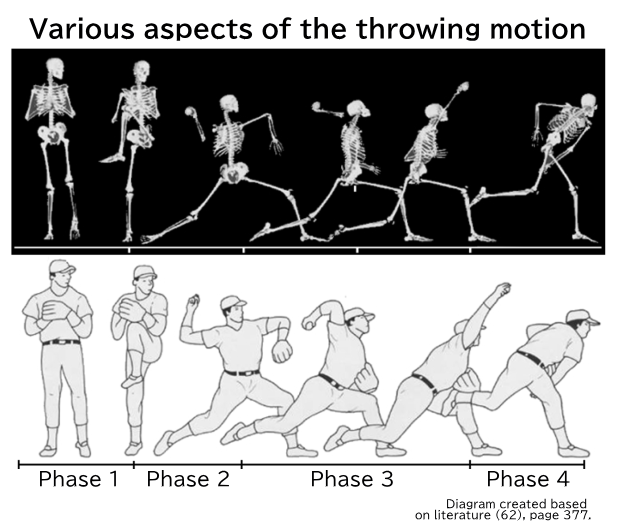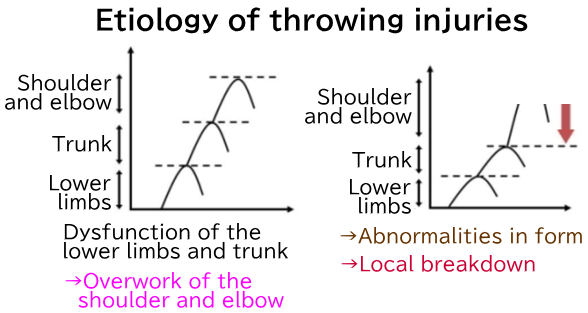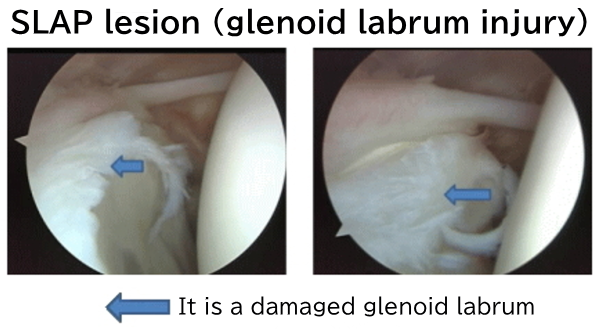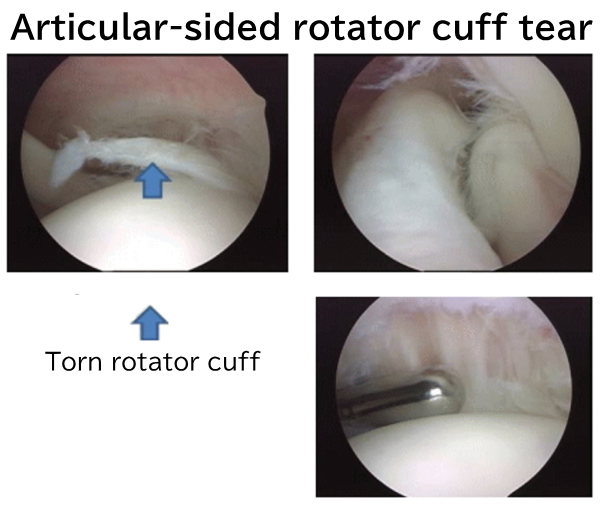Throwing Injuries(Throwing Shoulder Disorder)
Throwing Injuries
Throwing injuries can be found in the muscles and the tendons (rotator cuff injuries, long head of bicep brachii tendon injuries, rotator cuff tears), in the inner joints (SLAP tear), and in the capsule (subacromial bursitis, synovitis). Bennet lesion of the shoulder or unstable shoulders are also known as one of the throwing injuries.
Throwing injuries in the shoulder often occur in baseball pitchers, and the same symptoms can be seen in any athlete who participates in the sports which require repetitive overhead motions, such as volleyball, basketballs, and swimming.
Overhead throwing places extremely high stresses on the shoulder, specifically to the structure that keeps the shoulder stable. When these high stresses are repeated, you are prone to different overuse injuries. Do not give up, let’s find the ways to restore your shoulder.


Causes of throwing shoulder
Overwork of shoulder and elbow
Bad posture

Blue arrow: Labrum tear

Lateral view of rotator cuff tear
Blue arrow: Rotator cuff tear
As the illustrations show, it needs a series of body motions when throwing and hitting balls. Stable lower body will make the back turn, then it leads to extending the thoracic, and moving the scapular. Initiated with these motions, shoulder joints can move in a wider range. This makes the elbow and the fingers flexibly extended and then, you can throw stronger balls.
A smooth series of motions allows us to perform better without putting too much stress on the joints. However, the injuries can also happen very easily because the muscles become stiffer as you continue doing sports over time. Once the muscles get stiffer, it makes harder to perform as before, and the chain of the motions fails to function in harmony that may put heavier burden on the joints. This vicious cycle may result in SLAP tear or articular-sided rotator cuff tears.
Can we still play sports when the joint structure has problems?
Of course, yes. Athletes have been playing sports for many years even though some of them have shoulder problems. Overuse of shoulder or aging will accumulate the stress on the shoulder. Throwing injuries can occur when the series of body motions fail to work in harmony. What can be done to recover the shoulders? It needs to restore the smooth motion of the body through physical therapies.
When beginning the physical therapies, I put importance on how much you pay attention to the ideal movements to reduce the stress on the injured joints, and how well you physically gain the improved motion.
- Exercises for stabilization of head of humerus: To avoid the head of humerus popping out of the socket, see 2)
- Range of motion exercise: To improve flexibility for stable abduction motion
- Strengthening exercise: To strengthen muscle for balanc1)ed motions of rotator cuff, improved physical endurance
- Balanced dynamic alignment: To stabilize your body
- It is necessary to improve the range of motions in the scapular and the thoracic vertebrae, together with the shoulder joints. Please do not force yourself to expand arms too much. When you overstretch your arms to a horizontal abduction (expanding your arms laterally backwards), the stress is heavily placed on the labrum which may cause injuries.
- Flexibility is one of the most important elements to have a smooth chain of motions. If you do not have arm flexion for example, you will not expect better performances in throwing and hitting balls in the baseball.
- If you have a limited range of motion in one-part, the other part tries to work harder to cover up for the limitation which may result in having an excessive and abnormal motion or posture. Anatomically, the shoulders tend to lean forward, therefore, the heads of humerus are prone to slide off from the sockets. To keep the joints stable in the appropriate place, it is ideal to adjust the balance between the subscapularis and other muscles (supraspinatus muscle, Infraspinatus muscle, Infraspinatus muscle).
Please refer to the inner muscle training for baseball shoulders. I do not recommend that you practice tube training on your own because it may negatively affect the balance of the muscles.
- As stated above, we understand that the shoulders are prone to lean forward. When you have injuries in some parts of your body, your pitching form may lose the balance to avoid the pain, or to support injured parts. Your shoulders may be highly exposed to the changes and stresses caused by the injuries. Therefore, the patients need to be aware and feel that the shoulders are relaxed without having extra stress, rather than asking for physical therapists to teach them some routine workout.
There are many practices in physical therapies including manual physical therapies, massages, stretches, PNF(Proprioceptive neuromuscular facilitation) , Yoga, Pilates, Rolfing, and so on. It is highly recommended to work on these with the physical therapists.
If you do not have time to do so, please read the following training programs that you can do it yourself. I encourage you to continue exercises even though it takes some time to feel better. Exercises also affect the brain in many good ways.
Attention:
Please stop exercises when you have discomforts or pain. If you have any questions, please contact me.
Stretching exercises:
Upper limb
Core and Lower limb
Muscle training:
Inner muscle
Scapula
Core
ストレッチ
上肢編と体幹・下肢編に分けました。しなりを獲得する上で重要となります。
筋力トレーニング
インナーマッスルトレーニング、肩甲骨トレーニング、体幹トレーニングに分けました。
Shoulder Diseases

We provide explanations for various shoulder conditions. Please use this as a general guide to determine which condition may apply to you.
- Common shoulder injuries by age group
- To those who neither have frozen shoulder nor rotator cuff tears
- Throwing Shoulder Disorder
- Rotator Cuff Tears and Rotator Cuff Injuries
- Recurrent Shoulder Dislocation
- Frozen Shoulder
- Shoulder Dislocation
- Acromioclavicular Joint Dislocation
- Chronic Acromioclavicular Joint Dislocation
- Frozen Shoulder
- Calcific Tendinitis of the Rotator Cuff
- Primary Degenerative Shoulder Arthritis
- Rotator Cuff Tear-related Degenerative Shoulder Arthritis
- Non-traumatic Shoulder Instability
- Biceps Tendon Injuries
- Surgical Trends for Throwing Shoulder in Baseball Players
